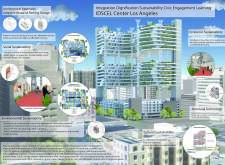5 key facts about this project
The IDSCEL Center represents a forward-thinking approach to urban development, merging functional housing with spaces for education, community interaction, and green initiatives. By repurposing an underutilized building, this project highlights a commitment to addressing both housing shortages and environmental concerns.
Sustainability and Community Engagement
The project uniquely integrates sustainable design philosophies through its ecological strategies and community-oriented spaces. The use of steel and glass as primary materials supports structural integrity while ensuring natural light permeates living and communal areas. The diagrid structure facilitates an open layout, allowing for various configurations of residential units. Extensive use of green roof systems and native vegetation enhances energy efficiency, promotes local biodiversity, and mitigates stormwater runoff.
Innovative design elements include curvilinear forms that challenge conventional high-rise aesthetics, facilitating better airflow and natural light access. These forms are not merely aesthetic; they also create inviting transitions between public and private areas, fostering a sense of community. Additionally, the inclusion of urban gardens and communal plazas promotes interaction among residents, encouraging a collaborative environment focused on sustainable living.
Mixed-Use Facility and Programmatic Diversity
Functioning as a mixed-use facility, the IDSCEL Center encompasses various programmatic components aimed at enhancing life quality for its residents. Affordable housing units are paramount, addressing the critical issue of homelessness and housing scarcity in Los Angeles. In addition to living spaces, the center includes educational facilities, child development resources, and public gathering areas, which are critical for fostering community engagement.
The architectural design prioritizes accessibility, offering features that cater to diverse user needs. Spaces for urban agriculture provide not only food production opportunities but also contribute to the community's educational initiatives surrounding sustainability. This well-rounded program highlights the project's intention to serve as a holistic community resource rather than merely a housing solution.
The IDSCEL Center stands out due to its comprehensive approach and innovative architectural strategies. It serves as a model for integrating sustainability and community needs within urban environments. To explore the detailed architectural plans, architectural sections, architectural designs, and architectural ideas that define this project, readers are encouraged to review the presentation materials for a comprehensive understanding of this significant urban initiative.























